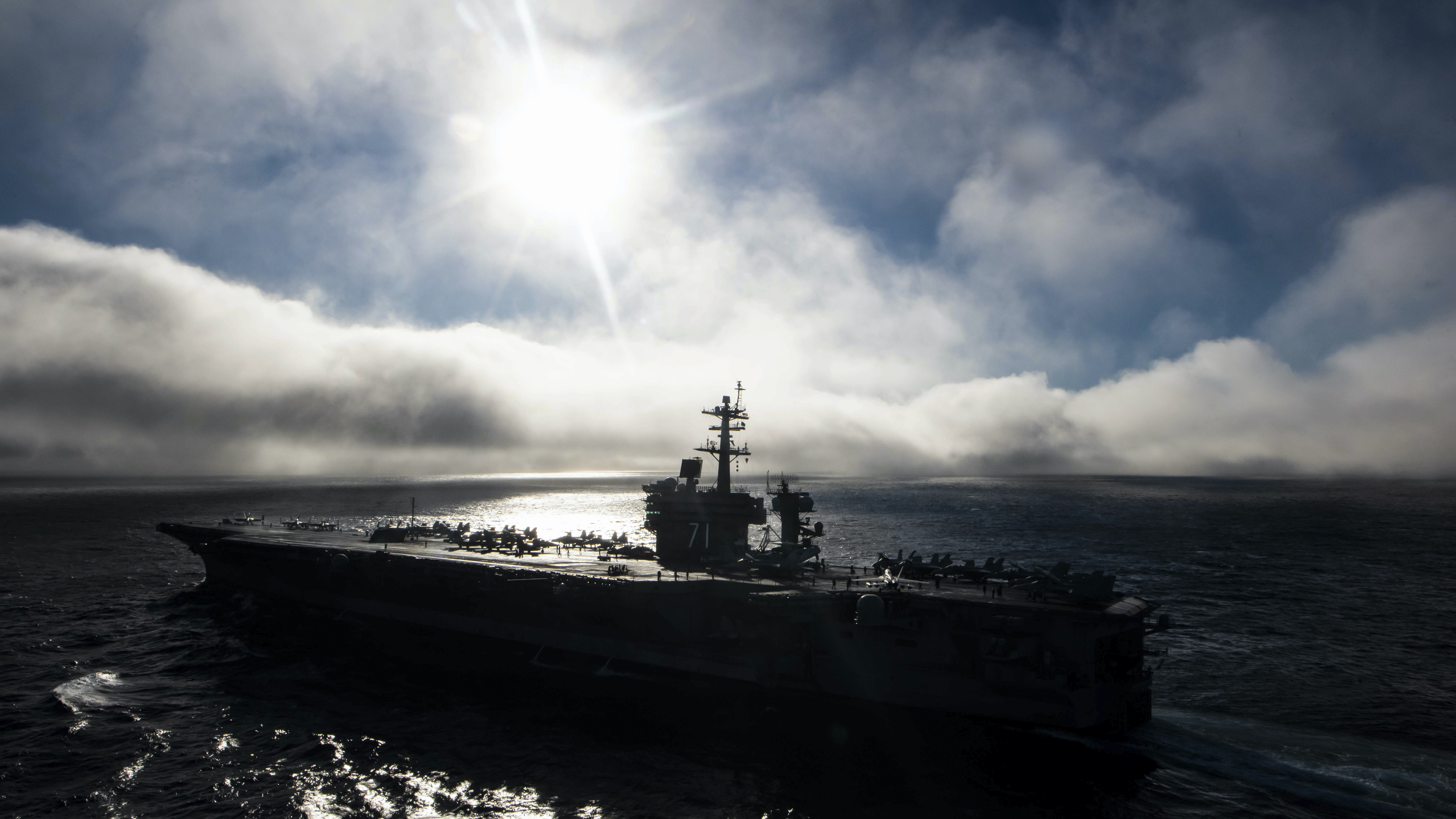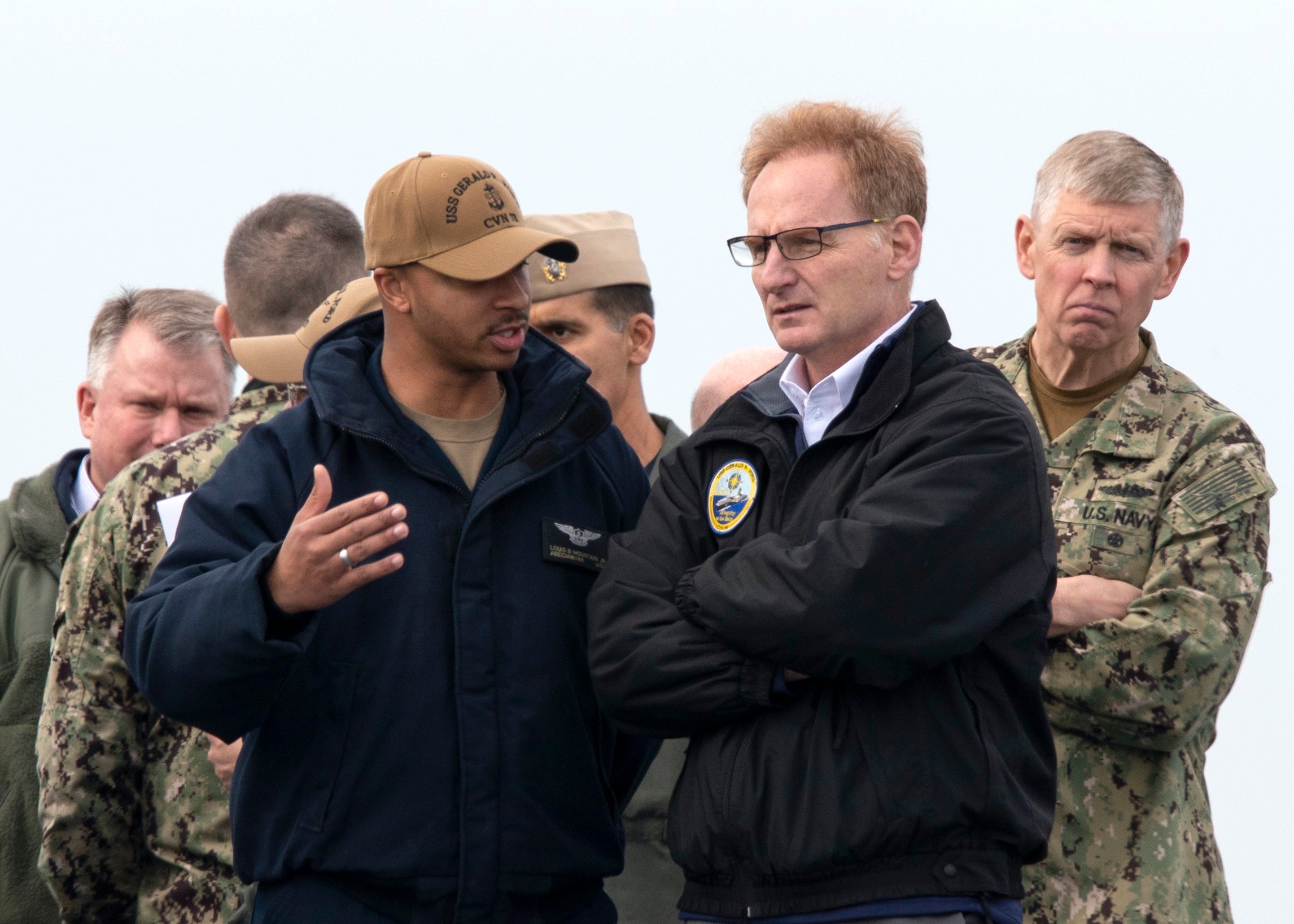
THE PENTAGON – The Navy has taken several cracks over the years at trying to define a new future aircraft carrier, one that might be less expensive or less vulnerable.
But each time, the Navy has moved forward with the nuclear-powered supercarrier concept, in part because it provides an unmatched sortie-generation capability, and in part, because it’s built by a workforce that would be tough or impossible to reconstitute if the Navy ever stopped supporting it.
But today, amid ever-increasing pressure to grow the fleet and clear indications that funding won’t be going up, the face of the future fleet is being scrutinized on all fronts, perhaps opening the door – even if just a crack – to seriously consider alternate carrier ideas.
Acting Secretary of the Navy Thomas Modly this week kicked off a Future Carrier 2030 Task Force effort to look at the future of aircraft carriers and carrier-based aviation. Modly acknowledged the next day, while talking to three reporters in his office, that changing how to think about the Navy’s largest platform has proven difficult in the past.
“I think I sort of want them to look at this from a clean-sheet perspective. Now, granted, doing that in a program like this is difficult to do because there are certain industrial capabilities that we have to keep in mind in order to do that. But I want them to think about, A – particularly these new Ford-class carriers that have a lot more capability than the Nimitz-class carriers do, significantly more power generation, the ability to launch all different kinds of aircraft more quickly, to include unmanned – how are we thinking about that and how we might deploy it in 20, 25, 30 years in terms of what would be on that ship? What would that mix look like? What would that carrier air wing look like on that?” Modly said in his office.
“But then looking beyond that, okay, do we continue to build those, or do we build something different? Do we look at maybe building something smaller? Maybe something conventionally powered? I don’t know the answer to that. These studies have been done before, so we’re going to dust off a lot of those again, look at the threat environment, and say, okay, this is maybe the right direction for us to go.”
But he said the context of today’s look – the Navy is trying to free up funds to grow in size, not looking for cuts to shrink – could potentially change the calculus. This carrier task force is taking place alongside an Office of the Secretary of Defense study of the Navy’s Integrated Naval Force Structure Assessment, which was meant to be a wholesale look at the future fleet, to include ship classes that don’t exist today and unmanned systems that are still in the development phase.
Cutting the aircraft carrier program – or drastically changing the face of it, for example, by choosing to pursue a conventionally powered carrier – puts at risk 57,000 jobs across 46 states, Modly said. But, the nuclear-powered carrier and submarine programs share many of the same suppliers, and it could be possible that if the carrier task force and the INFSA review worked in tandem, they could find an avenue that would allow for a different kind of aircraft carrier without wrecking the industrial base.
“Ultimately, we have to consider [the industrial base] when we look at everything. … We have to give industry enough time to be able to adjust,” Modly said.
“And we are going to continue to be building nuclear-powered submarines going forward, so the Columbia class, the Virginia class, whatever comes after the Virginia class. So we’re going to have to sustain that capability to do nuclear-powered ships. The question is, do we continue to do that on carriers, or is there some other alternative that makes more sense for us? I don’t know the answer to that, and that’s what we’re asking the group to look at.”

Modly didn’t get into the specifics of how to sustain the nuclear industrial base without a nuclear aircraft carrier. However, there has been some talk in the submarine community about continuing the Columbia-class ballistic missile submarine production line after buying the first 12 SSBNs and converting the design to a large-capacity guided-missile submarine (SSGN). The Navy already has a shortfall in its undersea portfolio, which is expected to get worse before it gets better, and the requirement for submarines is only going up as Russia and China expand their fleets. If industry needs could be accommodated with the pairing of increased submarine production across the SSBN, SSGN and attack submarine (SSN) lines and the creation of an alternate aircraft carrier – whether just a smaller nuclear-powered one or a large conventionally powered one – that could be a way to get at Modly’s goal of decreasing aircraft carrier procurement costs as a means to growing the fleet.
“Nuclear-powered carriers give us tremendous advantages because of their ability to both generate power, but their ability to move at certain speeds that conventional can’t, and they can be out for longer periods of time without having to be refueled, et cetera, all those advantages. And those are big advantages and those should be considered,” the acting secretary said.
“But then there are some other potential disadvantages to that as well, one being cost, the other one being size, and your ability to hide something that big is difficult, too.”
Ultimately, Modly acknowledged the need to take industrial base considerations seriously but also foot-stomped the need to seriously consider choosing a different future for the carrier force.
“We’re looking at how we can grow this Navy, how we can support Distributed Maritime Operations in the future scenario, in a threat-based scenario where we’re going to be dealing with a very unpredictable set of circumstances in the future. And so what platforms give us the best ability to respond to that? So you got the whole Pacific Ocean, Indo-Pacific theater set of challenges. You’ve got the whole Atlantic set of challenges. And now you’ve got Arctic challenges. You’ve got challenges in South America, in Africa. These are all maritime challenges in all these different parts of the world. I don’t think we’re going to retreat as a naval power, so how do we effectively build a force that can address all those things?” he said.
“So I know that there are a lot of people that – I don’t think people necessarily support the carriers purely for the economic and parochial reasons. I think there are people who believe in them because that’s the way the Navy has operated for the past 50 or 60 years. And that’s fine. But we have to think differently about the future, I think. So we need to think about what types of ships we might need in the future. And the carrier will likely be part of that, for the next 50 years for sure, but we need to start thinking beyond that as well.”
Modly’s Future Carrier 2030 Task Force will run for the next six months, until about September.
In the meantime, Defense Secretary Mark Esper’s review of the Integrated Naval Force Structure Assessment will run through about July.
Chief of Naval Operations Adm. Mike Gilday and Commandant of the Marine Corps Gen. David Berger presented their INFSA to Modly earlier this year after months of study, simulations and wargaming, but Modly kicked it back to them with concerns in a few areas.
“I wasn’t really uncomfortable with anything. But I would say that – I know that, for example, that they did various campaign analysis here in the Pentagon on that. I know that they did not pressure test that against the [Naval] War College. I know that they didn’t pressure test it through other types of wargaming scenarios. I know that, for example, they were very definitive about certain ship categories, and I would have been comfortable with them saying a range – we think it should be somewhere between this and this – but that’s not the way that they developed. So those are some of the major differences for me,” Modly said of why he didn’t immediately sign off on Gilday and Berger’s plans.
Modly said the INFSA was meant to be a starting point, with iterations each year to reflect new learning as unmanned systems hit the water, new needs as security threats evolve, and so on. But he said the issue of the carrier, especially, concerned him because of the trickle-down effect it could have on the rest of the wargaming and planning effort.
“Another good example is at the carrier, at the top of the list, your biggest capital asset. [The Navy has] said consistently that it should be 12 carriers. That’s what the law says. That’s what they put in all their scenarios. That’s a requirement that they put in there. Well, even if you looked at our own plans that we’ve developed, we never get to 12 in 50 years or something – I think 2060 or something is when we get to 12 carriers,” Modly said.
“So my view on that is, well, if we’re not going to ever really get to 12, why are we wargaming around 12? Why are we not wargaming around what we most likely will have? And then figure out how we manage risk in those areas where we would have take risk because we don’t have a carrier to do that. And so those are the types of discussions that we’ve had.”
Once Modly passed the INFSA up to Esper, the SECDEF chose to put the whole plan through another independent study before releasing it publicly or even to lawmakers, who are today trying to craft a Fiscal Year 2021 defense spending and policy plan without the benefit of the Navy and Marine Corps’ long-term plans. Modly said he would have liked to have gotten those documents to Congress alongside the budget request, but “I understand where he’s coming from on that, and so we’re supporting that effort.”





